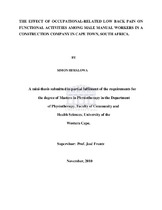| dc.contributor.advisor | Frantz, José | |
| dc.contributor.author | Himalowa, Simon | |
| dc.contributor.other | Dept. of Physiotherapy | |
| dc.contributor.other | Faculty of Community and Health Sciences | |
| dc.date.accessioned | 2013-06-19T11:59:51Z | |
| dc.date.available | 2013/02/20 15:44 | |
| dc.date.available | 2013/02/20 | |
| dc.date.available | 2013-06-19T11:59:51Z | |
| dc.date.issued | 2010 | |
| dc.identifier.uri | http://hdl.handle.net/11394/1490 | |
| dc.description | Magister Scientiae (Physiotherapy) - MSc(Physio) | en_US |
| dc.description.abstract | Construction manual workers are at a high risk of suffering from occupational related low back pain because of high-risk activities involved and the nomadic nature of the workforce. Low back pain and its associated disability continue to plague the construction industry. The prevalence of occupational related low back pain among manual workers in construction companies is believed to be due to high exposure to awkward postures for long hours, heavy manual work and exposure to whole-body vibration in the work environment. As a result of these risky exposures, low back pain has consistently been the leading cause of both occupational disability and absenteeism in the construction industry. The purpose of this study was to determine the effect of occupational related low back pain on the functional activities of the manual workers in a construction company in Cape Town. The prevalence and the predisposing factors of low back pain among construction manual workers were established as well as the effect of occupational-related low back pain on the functional activities of the manual workers was also determined. A crosssectional descriptive study using quantitative method was utilized. A convenient sampling method was employed and all the 212 available participants at two construction settings were recruited for the study. The population was categorised into four main occupational groups; masons, handymen, labourers and foremen. Data was collected using a structured questionnaire as a closed ended interview guide. The questionnaire comprised of four parts. Part one was used to determine the demographic data while parts two, three and four utilised three standardizedclose-ended validated questionnaires. These are; the Nordic Musculoskeletal Disorder Questionnaire, the Profile Fitness Mapping questionnaire and the Pain and Disability Questionnaire. Data was captured and analyzed using the statistical package for social sciences (SPSS) version 17.0 spreadsheet for statistical analysis. The study was conducted under the adherence of the ethical considerations. Descriptive and inferential statistical analyses describe the association between the investigated independent variables with the occurrence of occupational related low back pain in the study. Results are presented using tables, charts and graphs. The results revealed a 25% prevalence of low back pain while the one month and one week prevalence rates were 69% and 54% respectively. Masons recorded the highest low back pain prevalence rate (58%). Initial onset of low back pain was mainly attributed to bending (48%) and load lifting (28%). The chi-square test at p< 0.05 was done. The results revealed a lack of association between low back pain and the socio-demographic characteristics. Participants confirmed suffering physical, emotional, financial and functional problems with 41.5% reporting sickness absence and a mean of 4 days being lost during the past year. Further chi-square test for proportion revealed an association between low back pain and participants ‟ability to; lift (p=0.006), bend back forwards (p=0.001) and ability to bend back backwards (p=0.014). To prevent impairment, activity limitation and participation restriction among construction manual workers, a number of factors must be addressed at epidemiological level as highlighted in the recommendations of this study. | en_US |
| dc.language.iso | en | en_US |
| dc.publisher | University of the Western Cape | en_US |
| dc.subject | Cape Town | en_US |
| dc.subject | Construction manual workers | en_US |
| dc.subject | Disability | en_US |
| dc.subject | Low back pain | en_US |
| dc.subject | Musculoskeletal conditions | en_US |
| dc.subject | Occupational related low back pain | en_US |
| dc.subject | Occupational risk factors | en_US |
| dc.subject | South Africa | en_US |
| dc.subject | Prevalence | en_US |
| dc.title | The effect of occupational-related low back pain on functional activities among male manual workers in a construction company in Cape Town, South Africa | en_US |
| dc.type | Thesis | en_US |
| dc.rights.holder | University of the Western Cape | en_US |
| dc.description.country | South Africa | |

